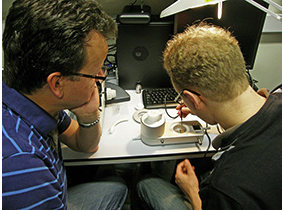Members Login

Channels
Special Offers & Promotions
Linkam Stages in use in the Wolfson Bioimaging Facility at the University of Bristol as Part of the Endocytic Sorting Research of Dr Paul Verkade
Market leaders in temperature controlled microscopy, Linkam Scientific Instruments report on the use of their temperature controlled stages applied to CLEM and fluorescence microscopy to assist in endocytic sorting in the School of Biochemistry at the University of Bristol.
 Dr Paul Verkade is a Reader in Cell Imaging in the School of Biochemistry at the University of Bristol where he also heads the Electron Microscopy unit of the Wolfson Bioimaging Facility. His current research focus is to develop techniques and tools for the use of Correlative Light Electron Microscopy (CLEM) studying endocytic sorting. Dr. Verkade is currently chair of the Electron Microscopy section of the Royal Microscopy Society and chair of the Cryo Microscopy Group, affiliated to the Royal Microscopy Society. He has also organised and taught on several courses and workshops on subjects such as high-pressure freezing, Correlative Light Electron Microscopy (CLEM), and immuno EM, including EMBO practical courses on CLEM.
Dr Paul Verkade is a Reader in Cell Imaging in the School of Biochemistry at the University of Bristol where he also heads the Electron Microscopy unit of the Wolfson Bioimaging Facility. His current research focus is to develop techniques and tools for the use of Correlative Light Electron Microscopy (CLEM) studying endocytic sorting. Dr. Verkade is currently chair of the Electron Microscopy section of the Royal Microscopy Society and chair of the Cryo Microscopy Group, affiliated to the Royal Microscopy Society. He has also organised and taught on several courses and workshops on subjects such as high-pressure freezing, Correlative Light Electron Microscopy (CLEM), and immuno EM, including EMBO practical courses on CLEM.
Looking at his research in more detail, Dr Verkade discusses his work. “The research in my group focusses on intracellular segregation processes, especially in the endocytic system (e.g. segregation of recycling cargo away from degradative). In order to study these processes, we use a lot of live light microscopy to follow these dynamic events. However the resolution of the light microscope is too low to visualise certain aspects (e.g. recycling membrane tubules are about 50 nm in diameter). Thus we want to capture specific stages of the live imaging and analyse those in more detail in the electron microscope in so-called Correlative Light Electron Microscopy experiments. There are several ways to perform those experiments and we use Linkam stages in two of those workflows.”
“In order to preserve the ultrastructure in its native condition, we have to freeze our samples very rapidly (for instance, chemical fixation destroys the membrane tubules). We can then check the state and fluorescence on these frozen samples using the Linkam CMS196 - Correlative Microscopy stage (sample image shown below). If the sample is OK, we can then further process it, either using cryo TEM or more often perform freeze substitution and resin embedding. It would be interesting to mention that Linkam is very cooperative in making special adaptations, in our case modifying the grid cassette holder to accommodate thicker samples which we have acquired using High Pressure Freezing, rather than the standard EM grids.”
“The second Linkam stage we use is a cooling stage. This one is used for our "photo-conversion" microscope, where by illuminating our fluorescent sample very heavily we create oxygen radicals that can be turned into an electron dense precipitate. However by shining so much light on our sample we heat it as well. Without efficient cooling of the sample using the water-cooled Linkam stage, we would burn our sample and it would literally melt / explode. Again, this is an essential tool in our CLEM workflow.”
Media Partners


